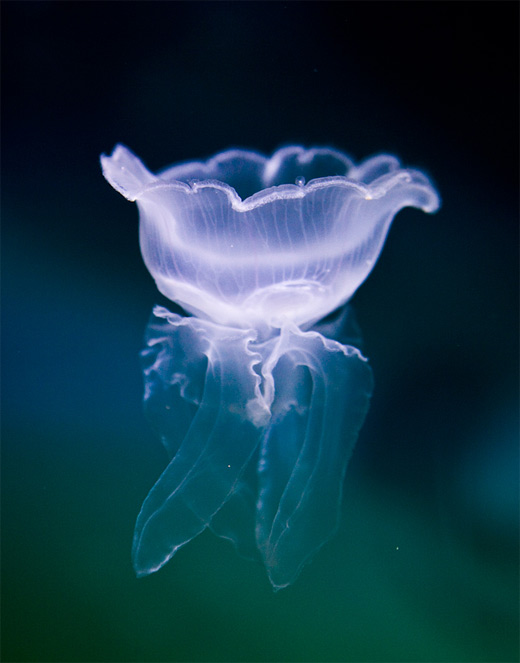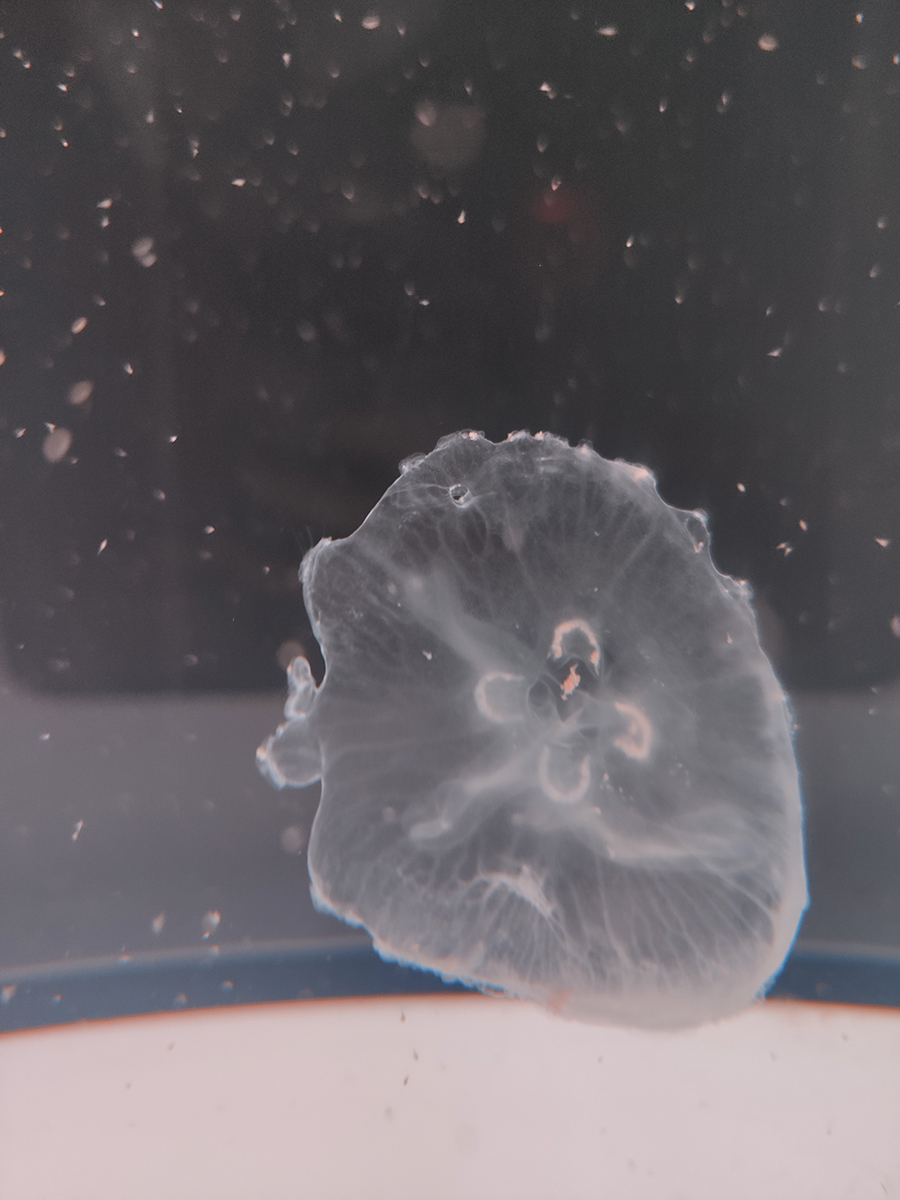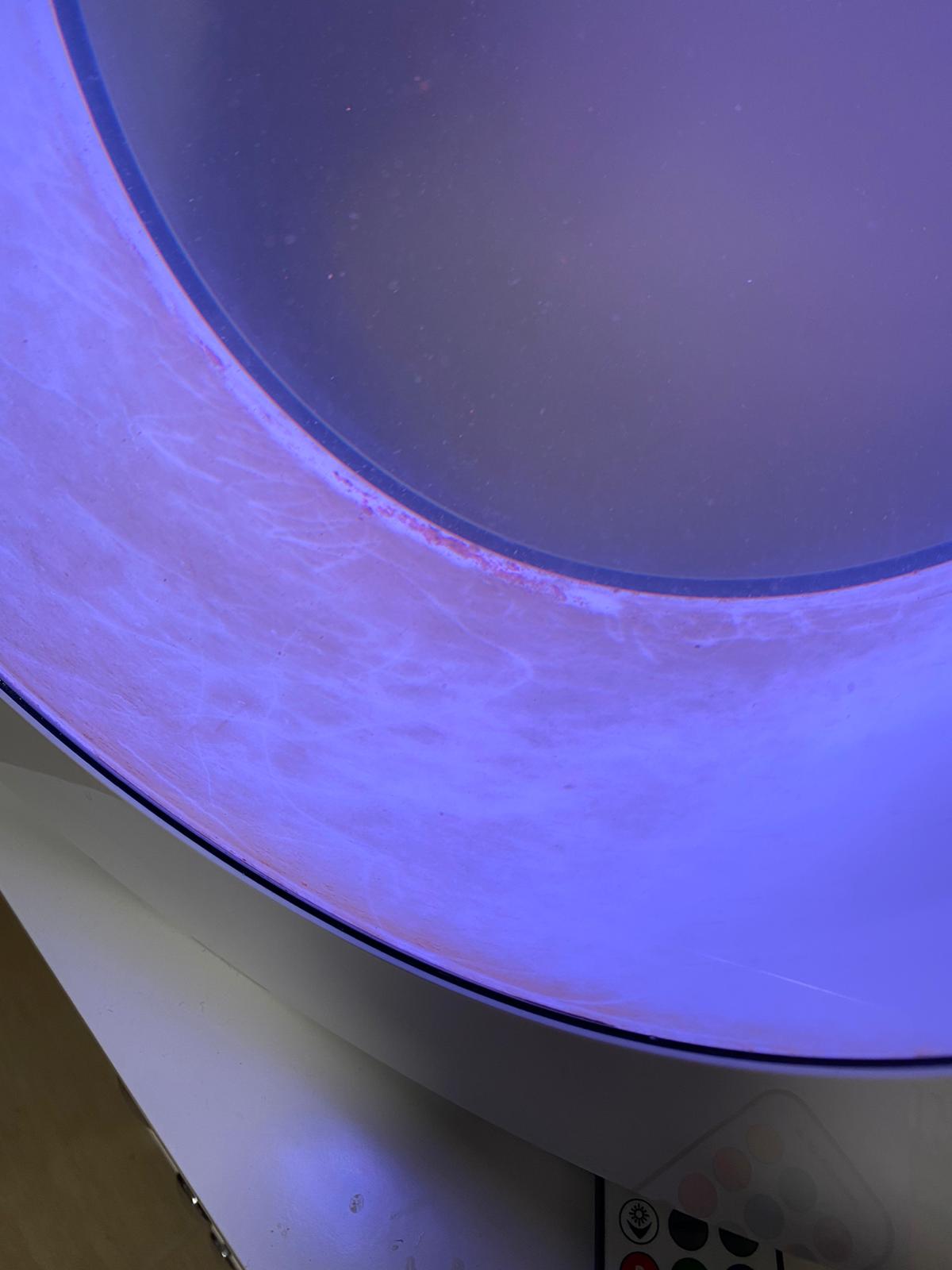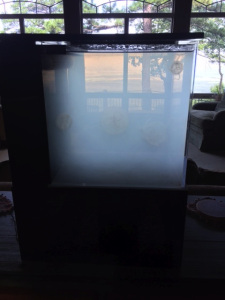Inicio / Information / Happy Jellyfish: Handling Potential Problems
Select a potential problem to understand: Why it happens and How to solve it
The jellyfish’s tentacles are the hair-like filaments located along the edge of the bell (umbrella). These contain the stinging cells jellyfish use to immobilize prey. Sometimes, white bumps appear on the tentacles—this is usually due to tangled tentacles.
Why Does It Happen?
This mostly occurs in tanks with low water flow, which causes the tentacles to become tangled. It can also happen when jellyfish frequently bump into the tank walls or each other. Fortunately, this condition is reversible if corrected in time.
Solution
Slightly increase the water flow speed according to the needs of the jellyfish you are keeping.
The larger the jellyfish and the more numerous they are, the stronger the flow should be to ensure proper movement and avoid tangling.
This condition occurs when the jellyfish inverts the edge of its bell upward, leaving the oral arms hanging down—giving it a goblet-like shape.

Why Does It Happen?
- Malnutrition:
A jellyfish that is not properly fed becomes thinner and is more prone to inversion. This usually gives warning signs—if it begins to flatten like a plate and shows reduced movement, it should be monitored closely. - Sudden changes in temperature or salinity:
Abrupt shifts can cause osmotic shock, affecting the proteins that support jellyfish tissue. Take special care during acclimation and water changes. - Insufficient water flow:
Low current may cause jellyfish to sink and stay on the bottom, leading to damage to the bell.
Solution
This condition is difficult to reverse, so it’s important to act early.
If you notice the jellyfish flattening or becoming inactive, check water parameters using a test kit and adjust the water flow accordingly.
In more severe cases, you may try to manually revert the bell shape.
Gently hold the jellyfish in your hands and use your fingers to unfold the umbrella. This maneuver often needs to be repeated several times.

Why Does It Happen?
Mechanical damage can occur if there is something inside the aquarium constantly rubbing against the jellyfish. This may result in visible tears or missing tissue.
Another common cause is suction injuries—when a jellyfish gets pulled into the filter intake. In these cases, you may notice lines or holes shaped like the overflow grid.
Damage can also happen accidentally during cleaning, such as if a jellyfish is unintentionally sucked up by the siphon or feeding pipette, causing tissue tears.
Solution
If the damage is not too severe, and the jellyfish is kept in a healthy, stable environment, it is often capable of regenerating and healing itself naturally.
Why It Happens
If you observe multiple holes on the top of the jellyfish’s bell, it may be due to a spike in ammonia levels.
Solution
Perform an ammonia test.
If levels are high:
Carry out a water change immediately.
You may also add an ammonia neutralizer after the water change.
Reduce feeding in the following days and monitor the jellyfish closely.
Retest ammonia after 3 days. If still high, repeat the water change.
If water parameters return to normal, the jellyfish should recover naturally.
However, if the jellyfish begins to disintegrate, the situation becomes critical and often irreversible.


Why Does It Happen?
Bubbles and microbubbles are extremely harmful to jellyfish. They can become trapped beneath the bell, or worse, ingested if mistaken for food.
As bubbles naturally rise to the surface, they can tear through the jellyfish’s tissue, creating holes.
Solution
Prevent bubble formation in the area where the jellyfish are housed.
If bubbles are already present and trapped:
Gently coax the bubbles out by stroking the jellyfish or using a pipette to help release them.
Always maintain proper water flow and avoid aeration systems that generate microbubbles near jellyfish.
Why Does It Happen?
A large hole may appear above the stomachs, sometimes accompanied by visible internal damage. This often occurs when the jellyfish have been fed spoiled or overly acidic food, which can cause ulcerations in their tissue.
Solution
Only feed jellyfish with fresh, high-quality food.
Never use food that shows signs of spoilage.
Keep food refrigerated, and only remove the portion you’re going to use.
If the jellyfish lives in a clean, stable environment, it may recover over time.
While jellyfish don’t pulse continuously and do have rest periods, a consistently listless appearance—especially with drooping oral arms and little movement—can indicate an issue.
Why It Happens
This inactivity is often linked to malnutrition: the jellyfish may not be receiving enough food, or the food may lack proper nutritional value.
High water temperature can also worsen the condition, so it’s important to monitor temperature and use a chiller if necessary.
Solution
Provide a nutritionally rich and varied diet to help the jellyfish regain strength and resume normal movement.
Live food, such as Artemia nauplii, is ideal and can be alternated with jellyfish pellets or prepared feeds.
If the water temperature is high, install a chiller to maintain an optimal, stable environment and prevent tissue deterioration.
Jellyfish should move openly, with visible radial canals, a smooth texture, and oral arms gently tucked under the bell.
When the edge of the bell begins folding inward, forming a ball-like shape, it’s a sign that something is wrong.

Why Does It Happen?
The exact cause is not well understood, especially when it affects only some jellyfish in the same tank, while others appear healthy.
It could be due to a developmental malformation—a natural percentage of jellyfish do not reach adulthood.
It may also stem from poor acclimation to the new environment.
Another possible cause is excessive water flow, which can stress the jellyfish and affect their shape.
Solution
This condition is very difficult to reverse, so early detection is key.
If you observe any signs of deformation:
Immediately test water parameters (pH, salinity, ammonia, etc.).
Adjust anything out of range to bring conditions back to optimal.
If flow is too strong, consider reducing water current to avoid further stress.
Jellyfish grow depending on:
The amount of food they receive
The size of the aquarium
The number of tank mates
With a proper diet and at least one feeding per day, they will grow slowly but steadily.
To accelerate growth, increase the feeding frequency throughout the day.
However, sometimes a jellyfish stops growing or even shrinks in size.
Why Does It Happen?
Shrinking or stalled growth may be caused by:
- High salinity/density levels
- Elevated nitrate (NO₃⁻) levels
- Water flow that is too strong, preventing the jellyfish from pulsing and swimming properly
Solution
Adjust salinity gradually.
→ Never pour freshwater directly over the jellyfish or onto the bio-balls of the biological filter.
Perform water changes (no more than 20%) to reduce nitrate levels.
→ Repeat every 3 days if necessary until levels normalize.
Adjust water flow to a gentle level, allowing jellyfish to swim freely and pulse comfortably.
→ This ensures they have enough time to feed and absorb nutrients effectively.
The oral arms of jellyfish should rest gently beneath the bell. However, it’s possible for one of the arms to detach unexpectedly.
Why Does It Happen?
The loss of an arm is usually a sign that one of the water parameters is out of balance—most commonly a spike in ammonia (NH₃).
It can also occur from overfeeding, especially if food is placed too directly on the jellyfish.
Solution
If the issue is an ammonia spike, perform an immediate water change.
Add Prime (or a similar ammonia neutralizer) to bind toxic compounds.
Jellyfish are highly resilient creatures—a new arm will grow back soon if the jellyfish is kept in a clean and healthy environment.
Sometimes your jellyfish tank may take on a yellowish tint, or you may notice brown stains on the aquarium walls.

Why Does It Happen?
This is usually due to elevated levels of phosphates and nitrates, which promote the growth of algae.
While not directly harmful to jellyfish, it gives the aquarium a neglected and unattractive appearance.
Solution
Clean the aquarium thoroughly:
Remove excess food
Rinse filter sponges with saltwater—preferably water from the tank itself
Let algae settle, then siphon the substrate
Address the root cause:
To prevent recurrence, reduce nitrate and phosphate levels
Place a pouch of Chemipure Blue Nano in the filter:
Absorbs excess waste
Contains activated carbon to clarify water
In the following days:
Avoid overfeeding
Optionally add cleaning bacteria to help maintain balance
With regular care and proper feeding, your tank will remain clear and visually appealing.
The aquarium appears white or foggy.

Why Does It Happen?
This is typically caused by a bacterial bloom.
While not immediately harmful to jellyfish, it often results from:
Overfeeding, which provides excess nutrients for bacteria to multiply rapidly
Disruption of the nitrogen cycle, which unbalances the tank’s bacterial population
Solution
Let it run its course — the bloom often resolves on its own as the system rebalances
You may perform a water change of no more than 20%
If the cloudiness persists, repeat the water change after three days
Avoid overfeeding and monitor water parameters to prevent recurrence.
